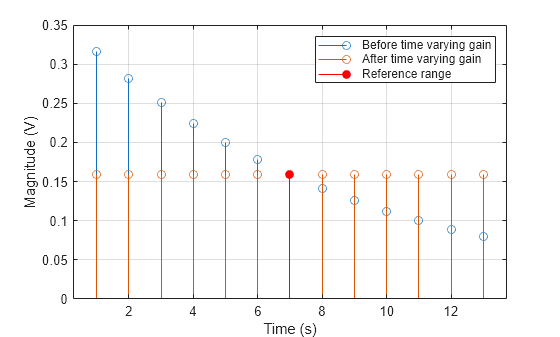phased.TimeVaryingGain
Time varying gain control
Description
The TimeVaryingGain object applies a time varying gain
to input signals. Time varying gain (TVG) is sometimes called automatic gain control
(AGC).
To apply the time varying gain to the signal:
Create the
phased.TimeVaryingGainobject and set its properties.Call the object with arguments, as if it were a function.
To learn more about how System objects work, see What Are System Objects?
Creation
Description
H = phased.TimeVaryingGain
H = phased.TimeVaryingGain(Name=Value)Name set to the specified
Value. Specify optional pairs of arguments as
(Name1=Value1,...,NameN=ValueN)
where Name is the argument name and Value is the
corresponding value. Name-value arguments must appear after other arguments, but the order
of the pairs does not matter.
Properties
Usage
Syntax
Description
Input Arguments
Output Arguments
Object Functions
To use an object function, specify the
System object as the first input argument. For
example, to release system resources of a System object named obj, use
this syntax:
release(obj)
Examples
Algorithms
References
[1] Edde, B. Radar: Principles, Technology, Applications. Englewood Cliffs, NJ: Prentice Hall, 1993.
[2] Skolnik, M. Introduction to Radar Systems, 3rd Ed. New York: McGraw-Hill, 2001.
Extended Capabilities
Version History
Introduced in R2011a
